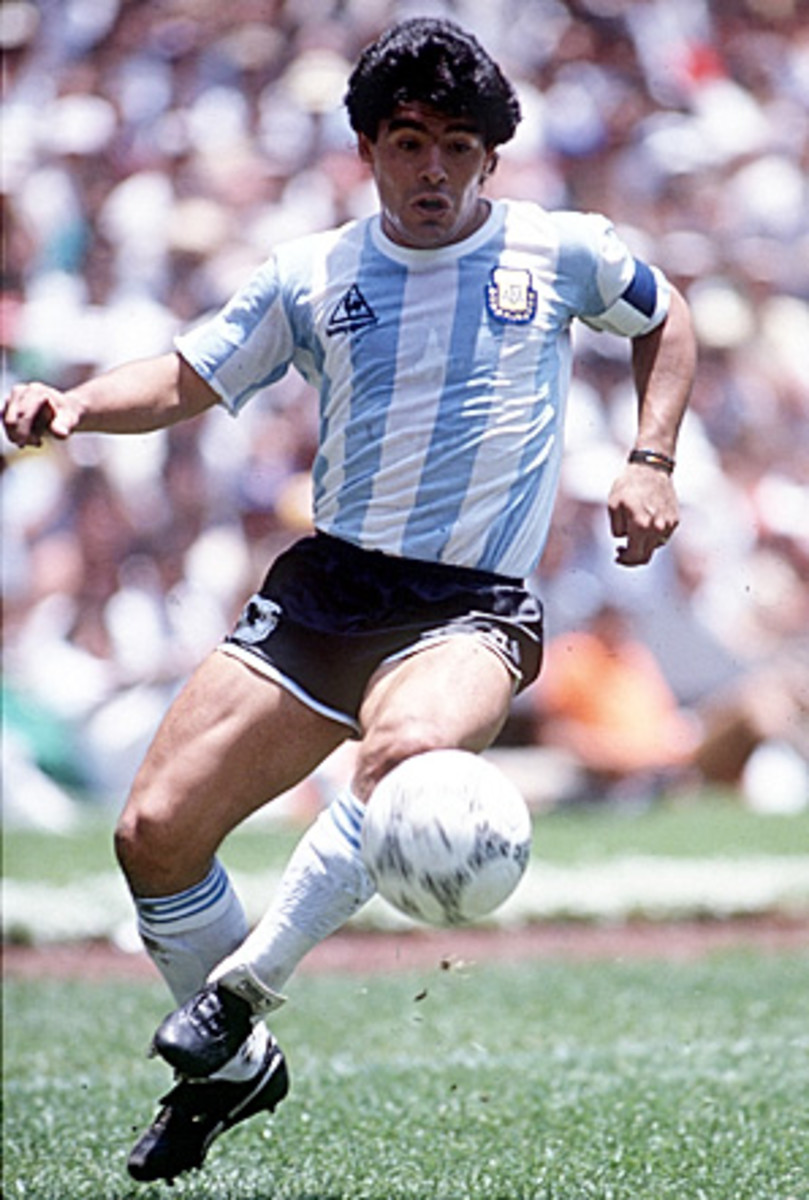Maradona the coach can learn from experience of Maradona the player
That is partly because Messi is such a phenomenon that, even in a world in which systems are far more important than individuals, he makes anything seem possible, but mainly it is because Argentina has done this before. In 1986, it was Maradona playing the Messi role, while the unpopular coach with the bizarre selection policy was Carlos Bilardo, who is now Maradona's assistant.
As a player, Bilardo helped Estudiantes to three straight Copas Libertadores, developing a reputation as somebody who would stop at nothing to win. He carried that mentality into coaching and was condemned by those who wanted Argentina to play the sort of expansive football it had in winning the 1978 World Cup.
"I like being first," Bilardo said on his Web site. "You have to think about being first. Because second is no good, being second is a failure. ... For me, it's good that if you lose you should feel bad. Football is played to win. ... Shows are for the cinema, for the theater. ... Football is something else. Some people are very confused."
In the early part of his reign, Bilardo himself was widely perceived as being confused, as Argentina won just three of his first 15 games, a run that included a humbling exit from the Copa America and a defeat to China in a mini-tournament in India. Argentina toured Europe in September 1984 and when Bilardo read out his team to face Switzerland in the first game, his reputation had sunk so low that it was widely assumed he had made a mistake.
"They told me I was wrong, that I'd named three central defenders," he said. "But I told them they should not panic, that everything was well. We were going to use three defenders, five midfielders and two forwards. We had practiced it for two years, and now I was going to put it into practice in tough games."
Argentina beat Switzerland 2-0 with the new system, and went on to beat Belgium and West Germany; the foundation was there. Whether Bilardo then hid his plan away, saving it for when it really mattered, or whether he simply kept tinkering is unclear, but Argentina's form heading into the 1986 World Cup was pitiful. It routed Israel 7-2 in its last warm-up game, but that was its first victory in seven games. As Maradona put it in his autobiography, fans watched Argentina's opening game against South Korea "with their eyes half-closed."
Argentina won comfortably enough, and progressed through the groups before beating Uruguay in the quarterfinal. Initially, Bilardo had used a 4-4-2, before switching to deploy Jose Luis Cuciuffo as a man-marker, picking up Giuseppe Calderisi in the second game against Italy. With Jorge Luis Brown operating as a libero, that effectively left Oscar Garre to push forward from left back to join the midfield, with Maradona as an attacking central midfielder.
Then, against England, Bilardo went back to the master plan (much as Alf Ramsey had waited until a quarterfinal against Argentina to unveil the master plan on which he had been working when England triumphed in 1966). In Brown, he had an uncomplicated defensive libero. In front of him were the two markers, Oscar Ruggeri and Cuciuffo, who picked up the opposing center forwards. Sergio Batista operated in front of them as a ball-winner, with Julio Olarticoechea -- preferred to the more defensively minded Garre -- and Ricardo Giusti wide. Jorge Burruchaga, as a link between midfield and attack, was a certainty, as, obviously, were Jorge Valdano and Maradona, which left just one position to fill. Pedro Pasculli had scored the winner against Uruguay in the previous round, but Bilardo decided to drop him, turning instead to Jose Enrique, a solid, unspectacular midfielder.
"You can't play against the English with a pure center forward," he explained. "They'd devour him, and the extra man in midfield will give Maradona more room."
So Maradona played as a nominal second striker, but given the freedom to roam wherever he saw fit by the defensive platform behind him. It produced two goals, the first illegal, the second brilliant, and Argentina progressed with a 2-1 win to a semifinal against Belgium.
Would a side with wingers have overrun Argentina? Possibly. It could be argued that its central midfield three of Batista, Enrique and Burruchaga would have dominated possession, but when England finally brought on John Barnes and Chris Waddle, they failed to cut out the supply to them even against a central midfield duo as lacking in ferocity as Glenn Hoddle and Steve Hodge. Still, it hardly mattered. Belgium had no wide players of any note -- who is to say it would have had the courage to play them even if it had? -- and restricted the semifinal to a midfield battle, only to be beaten 2-0 by two more majestic Maradona goals.
West Germany played its own version of 3-5-2 in the final and deployed Lothar Matthaus to mark Maradona. To an extent he was successful and, perhaps by the standards he had set in the tournament, Maradona did have a quiet game. But he still played a part in all three Argentina goals, while effectively negating Matthaus as Argentina won 3-2.
Never before or since has there been such a sense of a player winning a tournament single-handedly, but Maradona could only do it because of the tactical switch before the quarterfinal that gave him the freedom he needed. Messi has the potential to do the same in South Africa. The question is whether Maradona has the potential to let him.
Jonathan Wilson is the author of Inverting the Pyramid, Behind the Curtain, Sunderland: A Club Transformed and The Anatomy of England.





